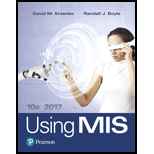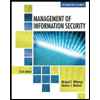
Using MIS (10th Edition)
10th Edition
ISBN: 9780134606996
Author: David M. Kroenke, Randall J. Boyle
Publisher: PEARSON
expand_more
expand_more
format_list_bulleted
Concept explainers
Expert Solution & Answer
Chapter 1.7, Problem 1SGDQ
Explanation of Solution
Password:
Sensitive information is present in every system or network and it requires authentication to open.
- The authorization is provided by entering the password, identification number, and so on.
- Password can be a string of character or number and it protects the system from the access of the unauthorized person.
Rule for creating a password:
The rules for creating password are:
- Password should be changed often.
- Password should not be guessable such as first name, last name and so on.
- The length of the password should be minimum 8 characters or more in length.
- It is good, if it has uppercase letters, lowercase letters, numbers, and special characters.
- It should not be a familiar word or pharse.
- It should not be common numbers like birth date and social security number.
- Password should not be shared with others.
Example of Weak password:
The examples of weak password are “FirstName_123”, “mypassword”, “mobile_number” and “123456789”.
Example of strong password:
The password with the combination of uppercase letters, lowercase letters, numbers, and special characters are considered as strong password.
Password Creation using the lines -“Tomorrow and tomorrow and tomorrow, creeps in its petty pace...
Expert Solution & Answer
Want to see the full answer?
Check out a sample textbook solution
Students have asked these similar questions
Considering the TM example of binary sum ( see attached)do the step-by-step of execution for the binary numbers 1101 and 11.
Feel free to use the Formal Language Editor Tool to execute it;
Write it down the current state of the tape (including the head position) and indicate the current state of the TM at each step.
I need help on inculding additonal code where I can can do the opposite code of MatLab, where the function of t that I enter becomes the result of F(t), in other words, turning the time-domain f(t) into the frequency-domain function F(s):
I need help with the TM computation step-by-step execution for the binary numbers 1101 and 11.
Formal Language Editor Tool can be used to execute it; Write it down the current state of the tape (including the head position) and indicate the current state of the TM at each step;
Chapter 1 Solutions
Using MIS (10th Edition)
Ch. 1.4 - Prob. 1AAQCh. 1.4 - Prob. 2AAQCh. 1.4 - Prob. 3AAQCh. 1.4 - Prob. 4AAQCh. 1.7 - Prob. 1EGDQCh. 1.7 - Prob. 2EGDQCh. 1.7 - Prob. 3EGDQCh. 1.7 - Prob. 4EGDQCh. 1.7 - Prob. 5EGDQCh. 1.7 - Prob. 6EGDQ
Ch. 1.7 - Prob. 7EGDQCh. 1.7 - Prob. 8EGDQCh. 1.7 - Prob. 1SGDQCh. 1.7 - Prob. 2SGDQCh. 1.7 - Prob. 3SGDQCh. 1.7 - Prob. 4SGDQCh. 1.7 - Prob. 5SGDQCh. 1.7 - Prob. 1CGDQCh. 1.7 - Prob. 2CGDQCh. 1.7 - Prob. 3CGDQCh. 1.7 - Prob. 4CGDQCh. 1.7 - Prob. 1ARQCh. 1.7 - Prob. 2ARQCh. 1.7 - Prob. 3ARQCh. 1.7 - How can you use the five-component model? Name and...Ch. 1.7 - Prob. 5ARQCh. 1.7 - Prob. 6ARQCh. 1.7 - Prob. 7ARQCh. 1 - Prob. 1.1UYKCh. 1 - Prob. 1.2UYKCh. 1 - Prob. 1.3UYKCh. 1 - Prob. 1.4CE1Ch. 1 - Prob. 1.5CE1Ch. 1 - Prob. 1.6CE1Ch. 1 - Prob. 1.7CE1Ch. 1 - Prob. 1.8CE1Ch. 1 - Prob. 1.9CS1Ch. 1 - Prob. 1.1CS1Ch. 1 - Prob. 1.11CS1Ch. 1 - Prob. 1.12CS1Ch. 1 - Prob. 1.13CS1Ch. 1 - Prob. 1.14CS1Ch. 1 - Prob. 1.15MML
Knowledge Booster
Learn more about
Need a deep-dive on the concept behind this application? Look no further. Learn more about this topic, computer-science and related others by exploring similar questions and additional content below.Similar questions
- Ensure you answer the question asked at the end of the document. Do not just paste things without the GNS3 console outputsarrow_forward"Do not use AI tools. Solve the problem by hand on paper only and upload a photo of your handwritten solution."arrow_forward"Do not use AI tools. Solve the problem by hand on paper only and upload a photo of your handwritten solution."arrow_forward
- "Do not use AI tools. Solve the problem by hand on paper only and upload a photo of your handwritten solution."arrow_forward"Do not use AI tools. Solve the problem by hand on paper only and upload a photo of your handwritten solution."arrow_forwardSolve this "Do not use AI tools. Solve the problem by hand on paper only and upload a photo of your handwritten solution."arrow_forward
- "Do not use AI tools. Solve the problem by hand on paper only and upload a photo of your handwritten solution."arrow_forward"Do not use AI tools. Solve the problem by hand on paper only and upload a photo of your handwritten solution."arrow_forwardSpecifications: Part-1Part-1: DescriptionIn this part of the lab you will build a single operation ALU. This ALU will implement a bitwise left rotation. Forthis lab assignment you are not allowed to use Digital's Arithmetic components.IF YOU ARE FOUND USING THEM, YOU WILL RECEIVE A ZERO FOR LAB2!The ALU you will be implementing consists of two 4-bit inputs (named inA and inB) and one 4-bit output (named out). Your ALU must rotate the bits in inA by the amount given by inB (i.e. 0-15).Part-1: User InterfaceYou are provided an interface file lab2_part1.dig; start Part-1 from this file.NOTE: You are not permitted to edit the content inside the dotted lines rectangle. Part-1: ExampleIn the figure above, the input values that we have selected to test are inA = {inA_3, inA_2, inA_1, inA_0} = {0, 1, 0,0} and inB = {inB_3, inB_2, inB_1, inB_0} = {0, 0, 1, 0}. Therefore, we must rotate the bus 0100 bitwise left by00102, or 2 in base 10, to get {0, 0, 0, 1}. Please note that a rotation left is…arrow_forward
arrow_back_ios
SEE MORE QUESTIONS
arrow_forward_ios
Recommended textbooks for you
- Np Ms Office 365/Excel 2016 I NtermedComputer ScienceISBN:9781337508841Author:CareyPublisher:Cengage
 Management Of Information SecurityComputer ScienceISBN:9781337405713Author:WHITMAN, Michael.Publisher:Cengage Learning,
Management Of Information SecurityComputer ScienceISBN:9781337405713Author:WHITMAN, Michael.Publisher:Cengage Learning,  COMPREHENSIVE MICROSOFT OFFICE 365 EXCEComputer ScienceISBN:9780357392676Author:FREUND, StevenPublisher:CENGAGE L
COMPREHENSIVE MICROSOFT OFFICE 365 EXCEComputer ScienceISBN:9780357392676Author:FREUND, StevenPublisher:CENGAGE L Principles of Information Systems (MindTap Course...Computer ScienceISBN:9781285867168Author:Ralph Stair, George ReynoldsPublisher:Cengage Learning
Principles of Information Systems (MindTap Course...Computer ScienceISBN:9781285867168Author:Ralph Stair, George ReynoldsPublisher:Cengage Learning


Np Ms Office 365/Excel 2016 I Ntermed
Computer Science
ISBN:9781337508841
Author:Carey
Publisher:Cengage

Management Of Information Security
Computer Science
ISBN:9781337405713
Author:WHITMAN, Michael.
Publisher:Cengage Learning,


COMPREHENSIVE MICROSOFT OFFICE 365 EXCE
Computer Science
ISBN:9780357392676
Author:FREUND, Steven
Publisher:CENGAGE L

Principles of Information Systems (MindTap Course...
Computer Science
ISBN:9781285867168
Author:Ralph Stair, George Reynolds
Publisher:Cengage Learning